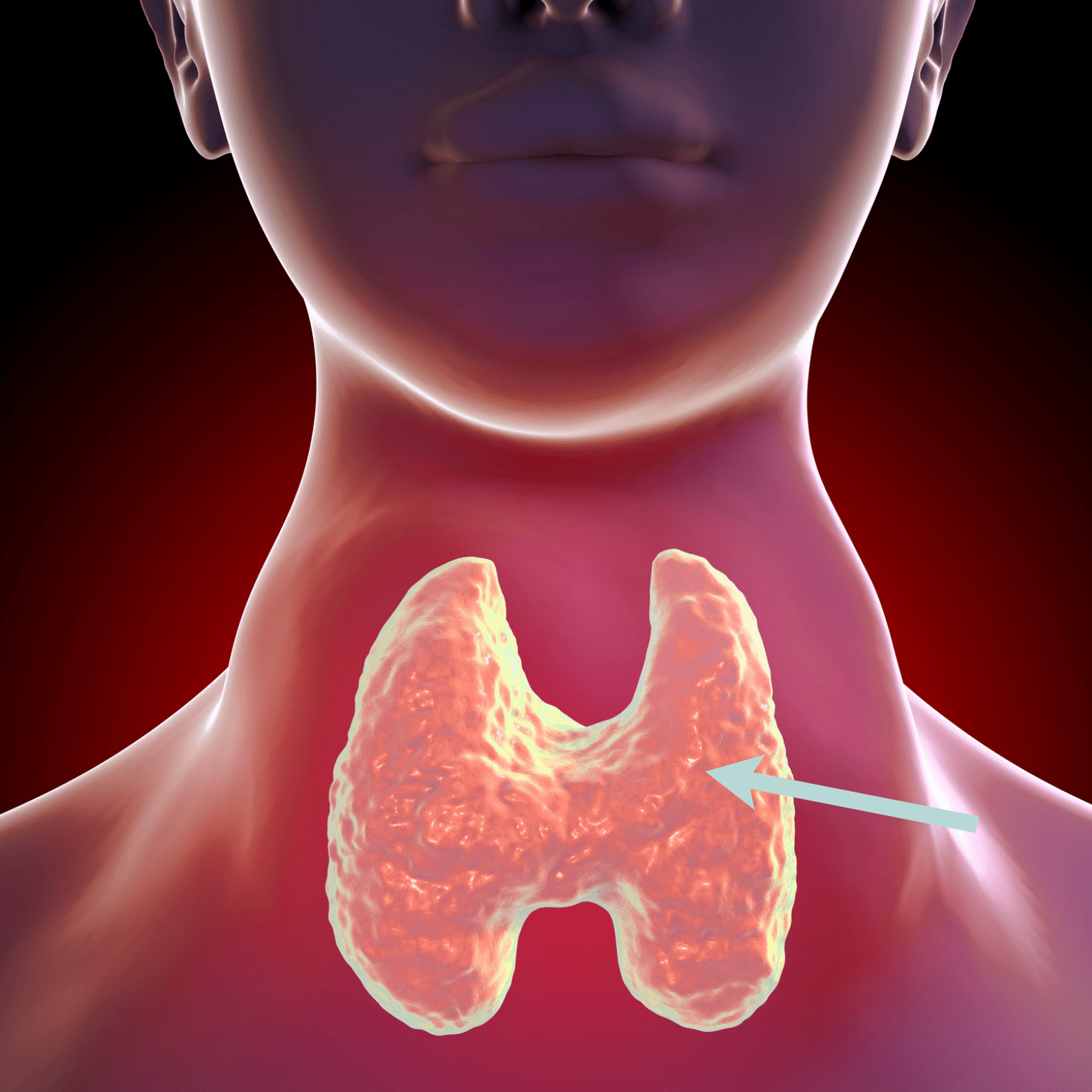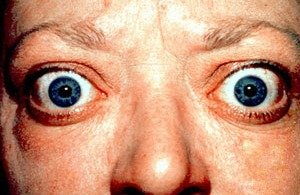Hyperthyroidism
content of this page
1- Introduction
2- Physiological Overview
3- Symptoms
4- Treatment
Introduction

Physiological Overview
Thyrotoxicosis is a condition resulting from any cause of increased levels of circulating thyroid hormone (TH). The terms thyrotoxicosis and hyperthyroidism are often used interchangeably. The prevalence of hyperthyroidism in the United States is estimated to be around 1.2%, with 0.7% classified as subclinical. Thyrotoxicosis can have various causes, and identifying the specific cause is crucial because treatment and outcomes differ accordingly.
Primary hyperthyroidism involves the excessive synthesis and secretion of TH by the thyroid gland. Diseases that can cause primary hyperthyroidism include Graves’ disease, toxic multinodular goiter, solitary hyperfunctioning nodules, and, rarely, follicular thyroid carcinoma.
Thyrotoxicosis can also occur transiently in conditions like subacute thyroiditis (viral, postpartum, painless, or de Quervain thyroiditis), where preformed TH is released. However, this is not considered true hyperthyroidism because there is no abnormal increase in TH synthesis, and the thyrotoxicosis is not sustained.
Another cause of thyrotoxicosis is the ingestion of excess TH medication, known as thyrotoxicosis factitia.
Secondary hyperthyroidism, caused by TSH-secreting pituitary adenomas, is very rare.
While each type of thyrotoxicosis has specific pathophysiology and manifestations, they all share some common characteristics.
Graves’ disease is an autoimmune disorder that stimulates the thyroid gland, leading to hyperthyroidism. It is the underlying cause of a significant majority of hyperthyroidism cases and has a prevalence of about 0.5% in the U.S. population. This condition is more frequently diagnosed in women. Graves’ disease presents as a multisystem syndrome characterized by:
- Hyperthyroidism
- Diffuse enlargement of the thyroid gland (goiter)
- Ophthalmopathy (eye changes, such as bulging eyes or double vision)
- Dermopathy (skin changes, typically non-pitting edema or thickening)
These symptoms and manifestations vary in severity among individuals affected by Graves’ disease.

Symptoms
Metabolic Effects:
- Weight Loss: Despite increased appetite.
- Heat Intolerance: Feeling excessively warm, especially in hot weather or indoors.
- Increased Sweating: Perspiring more than usual.
Cardiovascular Symptoms:
- Rapid Heartbeat (Tachycardia): Palpitations or irregular heartbeat.
- High Blood Pressure: Elevated blood pressure.
Nervous System Symptoms:
- Nervousness and Anxiety: Feeling jittery or on edge.
- Irritability: Easily becoming annoyed or angry.
- Tremors: Fine trembling or shaking of hands and fingers.
- Difficulty Concentrating: Trouble focusing on tasks or memory issues.
- Insomnia: Difficulty falling asleep or staying asleep.
Musculoskeletal Symptoms:
- Muscle Weakness: Particularly noticeable in the upper arms and thighs.
- Muscle Wasting: Loss of muscle mass over time.
Gastrointestinal Symptoms:
- Increased Bowel Movements: More frequent trips to the bathroom.
- Diarrhea: Loose or watery stools.
Reproductive and Menstrual Changes:
- Irregular Menstrual Periods: Lighter or less frequent menstrual periods in women.
- Fertility Issues: Difficulty getting pregnant.
Other Symptoms:
- Goiter: Enlargement of the thyroid gland, which may be visible or felt as a lump in the neck.
- Eye Problems: In Graves’ disease, symptoms may include bulging eyes (exophthalmos), dryness, irritation, double vision, or vision changes (Graves’ ophthalmopathy).
- Skin Changes: Such as thin, delicate skin or increased sweating.
Treatment
Antithyroid Medications:
- Methimazole (Tapazole) or Propylthiouracil (PTU): These medications inhibit the production of thyroid hormones by the thyroid gland. They are typically used as initial treatment for mild to moderate hyperthyroidism, and may be continued for 12-18 months to achieve remission.
- Monitoring: Regular blood tests are necessary to monitor thyroid hormone levels and adjust medication dosage as needed.
Radioactive Iodine Therapy (Radioiodine Ablation):
- Administration: Radioactive iodine (radioiodine) is given orally and selectively taken up by the thyroid gland. It destroys thyroid tissue, reducing hormone production over several weeks to months.
- Effectiveness: This treatment is highly effective and often used as a permanent solution, particularly in Graves’ disease or toxic nodular goiter.
- Considerations: It may lead to hypothyroidism (underactive thyroid) over time, requiring lifelong thyroid hormone replacement therapy.
Surgery (Thyroidectomy):
- Procedure: Surgical removal of part (subtotal thyroidectomy) or all (total thyroidectomy) of the thyroid gland.
- Indications: Recommended if antithyroid medications are not tolerated, if there is a large goiter causing compression symptoms, or if cancer is suspected.
- Risks: Potential risks include damage to the parathyroid glands (which regulate calcium levels) and the recurrent laryngeal nerve (which controls the vocal cords).
Beta-Blockers:
- Purpose: Medications such as propranolol or atenolol may be prescribed to manage symptoms like rapid heartbeat (palpitations), tremors, anxiety, and heat intolerance while awaiting the effects of other treatments.
Supportive Care and Monitoring:
- Ongoing Monitoring: Regular follow-up visits with healthcare providers to monitor thyroid function, adjust medications, and manage any complications or side effects.
- Management of Eye Symptoms: In Graves’ disease, specific treatments may be needed to manage eye symptoms (Graves’ ophthalmopathy), including lubricating eye drops, corticosteroids, or surgery in severe cases.